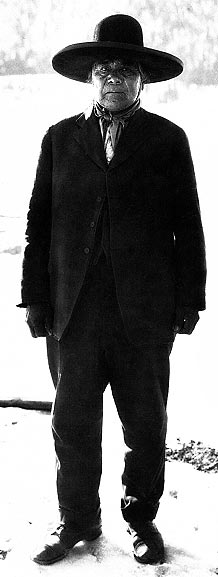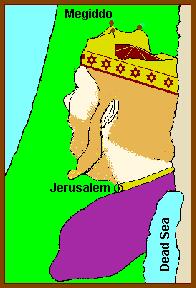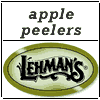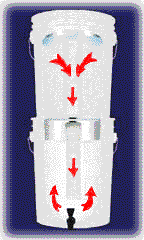From Kurt Saxon's Home Page:
www.survivalplus.com
The text and illustrations of this article are from Organic Gardening
and Farming January, 1972
THE BACK YARD FISH FARM
The new series of reader research projects starts with an
exciting plan to turn grass clippings into organic fish.
Dr. John H. Todd with Dr. William 0. McLarney, Director of Aquaculture
Studies for the New Alchemy Institute
OVER THE PAST FOUR MONTHS in the series "Shaping an Organic America" I have
dealt with the urgent need to create a science and biotechnology which will
permit revitalization of the countryside along organic and ecological principles.
It is my belief that if such a science is developed and its findings put
into practice, an ecological crisis of saddening dimensions can be averted.
I have also pointed out that there is no guarantee for the development of
a truly ecological science by the scientific community alone. Most scientists
simply are not trying to set examples for the future by living and working
with the earth. Because of this, the recommendation was made that the science
for the organic method should marshal the participation of many, many people
from all walks of life arid particularly you who are already working with
the land. If this were to happen, then a true restoration of the countryside
might be possible. I know that this is a tall order and no doubt the concept
will be scoffed at by many scientists. Yet, my confidence in the whole idea
of the Readers' Research Program has been bolstered by the letters I have
received following my article in the November issue of OGF. Several really
ingenious and even brilliant ideas have been presented by a number of people.
(In a future issue I would like to describe some of these exciting plans
and discoveries which are not directly associated with the experiments outlined
in this column.)
EDITOR'S NOTE: An extensive bibliography of articles and books for more detailed
information on fish farming has been prepared by Drs. McLarney and Todd.
For a copy of the brochure of references and source materials, please send
50 cents to "Aquaculture Bibliography," Rodale Press, Inc., Emmaus, Pa. 18049.
(I left this paragraph in place just so it could be said that I posted this
article in it's entirety. But since this work is 25+ years old, I doubt very
seriously if you'll find any of it's references still viable.---Cary)
In the entire history of man, there has probably never been a period quite
like now when so many people feel a sense of despair and helplessness towards
the future. I think this can be changed if enough people are able to see
even the slightest possibility of embarking upon a personal course of action
which will truly benefit the planet as well as themselves.Organic gardening,
farming and homesteading are among the most positive steps that can be taken
in this direction. Involving ourselves in creating a science for tomorrow
is a commitment upon which so much will depend. This month inaugurates the
Readers' Research Program and for many of you working with us, it will be
a way of beginning, in the words
of Bob Rodale, "1972 as the Year for Organic Action."
Introducing the Readers' Research Program
New Alchemy Institute scientists, with the support and collaboration of the
editors of ORGANIC GARDENING
Organic Gardening and Farming - January, 1972 - Page 99
And Farming magazine, will be working with you to organize a widespread,
continuing research program to investigate many of the important organic
concepts. As gardeners and homesteaders you will have the opportunity this
year to become involved in any one of at least three scientific projects.
Besides the Back Yard Fish Farm research which is described in this article,
the second project will involve a country-wide search for the most pest-resistant
varieties of vegetables. At the present, this essential information is not
widely available to the organic gardener.
The third Readers' Research project planed for 1972 will investigate ecological
design in agriculture. Specifically, we will compare complex interplantings
of vegetables in home gardens with single or monocrop plantings. Soil fertility,
resistance to pests and a number of other variableswill be measured and the
differences between the two approaches will be analyzed.
I would like to begin by describing the way in which the Readers' Research
Program will be organized. Each of the research projects will be outlined
in these pages. After you have read the articles outlining the projects,
if you are seriously interested in working with us on a specific experiment,
please inform us of your intent to become involved. The address is: The New
Alchemy Institute, Box 432, Woods Hole, Mass. 02543. After you contact us
we will send further instructions on how to set up the experiments, what
equipment you will need, where to get it, and how much it will cost.
There is one point I would like to emphasize at this time. If the research
program is going to succeed and be an important source of information, please
do not ask us for project instruction booklets unless you honestly intend
to carry out experiments with us, and have the space and facilities to do
so. The booklets cost money, and replying to casual inquiries takes up valuable
time. Since we are operating this program on a relatively low budget, the
time and money you save us will give us a greater opportunity to work toward
the success of the program. All the information you need to make a decision
about your participation can be made on the basis of what you read in this
column. The booklets will only add the "how-to" details and outline some
of the potential pitfalls that the investigator needs to know about.
The organization of the first project, the Back Yard Fish Farm, will be slightly
different. It is possible that the number of people who would like to become
involved will exceed the supply of brood stock which we have available. Thus,
we will have to limit the study to match the supply of fish. The procedure
for the Back Yard Fish Farm will be as follows: First, if you are seriously
planning to get involved, contact us. Then, just prior to constructing the
dome and installing the pool, you must contact us again to see if the fish
are available. If we say yes, fish will be reserved for you. When the fish
farm is built and a picture of it sent to us, we will ship the fish for the
experiment.
Becoming involved in a research program may also provide a bonus that you
may not have counted on; you will get to know the nearest organic
gardener-scientist working on the same project. If at all possible, we will
try and send you the address of the nearest participant, so that you can
work together if you wish.
As the growing season proceeds you will continue to collect scientific data.
At the end of the season your results will be sent to us for tabulation and
be included with the findings of other investigators. Finally, we will describe
the results in these pages and in research publications. Within a few years
we will be able to make recommendations to you that have a large
Organic Gardening and Farming - January, 1972 - Page 100
and meaningful body of knowledge to back them up. It is just possible that
the Readers' Research Program will help create the wisdom that will guide
those of us who are working with the land.
The Back Yard Fish Farm, A Revolutionary New Way To Raise Foods at Home
Dr. William 0. McLarney and I are working together to organize the Back Yard
Fish Farm research. The project involves a totally revolutionary concept
in agriculture. If it should prove successful, fish farming, on a small scale
at least, could become a common practice throughout the country. We are proposing
that you raise fish in a small pool inside a geodesic dome using intensive
culture methods. You will create tiny fish farms which are organic and capable
of producing foods of excellent quality. If you have ever enjoyed keeping
an aquarium of tropical fishes, then I think you will receive the same pleasure
as well as a food crop from the Back Yard Fish Farm.
In the November issue of OGF, I described some of the thinking and theoretical
concepts which went into our Back Yard Fish Farm prototype. I also outlined
the reasons for choosing herbivorous fishes from the tropics and using the
dome to create a suitable climate. I think it would be wise to reread that
article, as space limitations prevent my repeating it. This research project
will use the same methods and fish (tilapia) as we did in our prototype.
What I didn't point out in the November article is the necessity for developing
organic methods in aquaculfure. It has become clear to us that organic fish
products are desperately needed in this country. The area of Cape Cod in
which Bill McLamey and I live is dotted by tiny lakes, many of which provide
good fishing. Bill, an ardent fisherman, can be seen often casting for pickerel,
perch or bluegills. His harvest is an important source of food for a number
of us. Since fish are one of the most complete, health-giving foods, we usually
jump at the chance to eat them — or at least did, until a pesticide-chemist
friend examined our fish. The little pond in the woods, far away from industry
and agriculture, is contaminated. The perch we were eating had up to 40 parts
per million of DDT in their fatty tissues. This is far above the allowable
limit for foods. We already knew that many marine fishes are contaminated
with a variety of harmful substances, but the pond was the last straw. We
had to start figuring out ways to grow fish organically and cheaply and we
had to do it soon. Philosophically, we were committed to small-scale intensive
systems, based upon ecological and organic principles. If the fish were to
be relatively poison-free, their diet would have to consist of aquatic plants
and algae; this would shorten the food chain and make the system more productive
while less prone to accumulating harmful substances in the fish. The prototype
we developed will act as a model for the initial OGF research project.
How To Do It
The first task of the experimenters in the Back Yard Fish Farm research will
be to build an inexpensive geodesic dome which will house the pool for raising
the tilapia. Tilapia are excellent and much revered tropical fish which will
primarily eat the algae you grow right inside the pool. In order for the
tilapia to grow to an edible size, which is about one-half pound, a growing
season that's at least six-months long in water that is normally well above
70 degrees F. will be required. The dome provides these high temperatures
by trapping the heat from the sun, which is stored in the pool and transformed
into algae growth. The fish will die if the temperature drops much below
60 degrees F. Their vulnerability to cold
is one of the reasons we chose this
Organic Gardening and Farming - January, 1972 - Page 101
fish. If some careless person ever takes them out of the dome and puts them
in a local stream or lake they will not survive the winter to upset the natural
ecosystems. This is not true for the Imperial Valley in California, parts
of southern Florida and southern Texas. Although tilapia are now found wild
in these areas, we do not plan to aggravate the problem of exotics by conducting
experiments in these regions where they can survive outside the dome.
The dome is a very effective heat trap and the pool is quite an efficient
heat retainer. At the time of this writing, which is late October, the water
temperature in our prototype Tilapia-Dome is still in the 60s even though
the outside temperatures have been dropping near freezing at night. With
the addition of a little bit of heat, we have been able to push the temperatures
up into the 70s during the cool days of fall. With design improve ments in
the dome, we think that even in our climate, the addition of heat will not
be necessary in the future.
Building the Dome
Building a geodesic dome is relatively easy and inexpensive. You should plan
on two or three days to complete the task. Some of you living in the more
southerly regions of the country will be able to build them for less than
$50. More sophisticated structures, incorporating a double skin of clear
greenhouse vinyl with an air layer in between to prevent heat loss, will
last for a number of years but could run as high as $200 for materials.
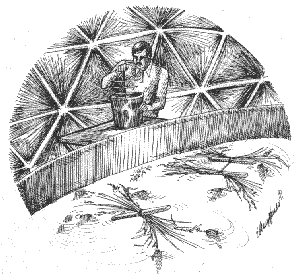
Feeding time in the tilapia dome. Their main diet will be the algae which
grow in the pool, but it should be enhanced with small amounts of insect
larvae.
complete the task. Some of you living in the more southerly regions of the
country will be able to build them for less than $50. More sophisticated
structures, incorporating a double skin of clear greenhouse vinyl with an
air layer in between to prevent heat loss, will last for a number of years
but could run as high as $200 for materials.
Our prototype was a dome 18 feet in diameter, although we wished that it
had been larger. One problem was that we couldn't move around the 15-by-10-foot
pool inside. This was annoying as I had wanted to start some plants growing
inside, and to do more insect-culturing research to provide new kinds of
supplemental foods for the fish. The optimal size for domes to be used in
the Back Yard Fish Farm would be 25 feet in diameter. This size should provide
freedom to work inside while allowing a greenhouse area. All of our future
research domes will be of the larger size. Costs begin to shoot up drastically
when the diameter exceeds 25 feet. Our dome was built by Multi Fassett and
Marsha Zilles of Earth House in Cambridge. The plans they used and strongly
recommend for the Back Yard Fish Farm research can be obtained from Popular
Science magazine, 355 Lexington
Organic Gardening and Farming - January, 1972 - Page 104
Avenue, New York, N.Y. 10017. (Ask for the Sun-Dome Plans.) The plans and
instructions cost $5 and include a license to build it from the inventor,
Buckminster Fuller. You should also read Knight Starr's OGF article in the
September 1971 issue on the geodesic greenhouse. Although this dome is too
small for the fish experiments, he does provide a lot of valuable information.
If any of you have access to a cheap supply of window glass, you may be able
to build an experimental dome which will last for many years.
The Pool
The pool can be any type of children's swimming pool, which varies in price
from about $40 to $100. We used a 15-by-10-by-4-foot-deep, almost rectangular
pool with a 3,400-gallon capacity. We assumed that this shape would be more
conducive to breeding fish, but this original supposition was not correct.
A 12-to-14-foot-diameter pool, 3 feet deep would do just as well and cost
much less. The
volume of this pool would be close to that of the prototype since we only
filled ours to a depth of three feet.
There is an alternative way of constructing a pool which would be less expensive:
digging a pond in the ground, about three or four feet deep and 12 to 15
feet in diameter. Since we haven't tried this method, we don't know how well
it will work. If your soil is heavy and contains clay, lining the pool to
prevent water seepage will not be needed. One problem that we can foresee
with the pond-pool is the loss of heat from the water into the surrounding
soils. This might be minimized by the use of an inexpensive liner combined
with a good insulating material.
Fish for the Back Yard Fish Farm
Tilapia, a tropical fish native to Africa and the Near East, will be used
in the experiment. They eat algae, the microscopic plants that color lakes
green. This coloration is especially prevalent in the summer months. Because
it is possible to grow algae in huge amounts and at almost no cost, algae-eating
fish can be raised quite cheaply.
Each of the experimenters participating in the project will receive one pair
of tilapia parents from us. The only cost to you will be shipping and handling
fees, which might run as high as $25, depending on where you live. However,
if they survive and breed, this will be the only investment in tilapia you
will ever have to make. Once established, the parents will be capable of
producing thousands of young per year. This will supply you with plenty of
offspring and you will be able to pass them on to any friends who may be
interested in starting their own Back Yard Fish Farm.
Place the adults you receive in the dome pond. As soon as the temperature
climbs to the low 80s they will start to breed and lay eggs which they care
for in their mouths. Don't panic at this stage; they are not eating their
young. Tilapia are members of a group of fishes known as mouth-breeders.
After the brood is hatched and swimming freely about the pool, the parents
will breed again if conditions are right. This process should continue until
an optimal population density for your experimental pool is reached. If,
after sampling the population, you find that there are more than 500 fish
in the pool, you should pull the parents out to prevent overpopulation and
stunting of the residents.
After the first year's growing season is over, if the conditions have been
favorable, you will have an excellent crop of edible fish. These can be frozen
or stored live in aerated tanks for eating fresh as needed. The Malayan peoples
in the Orient often store their live fish in rain barrels just outside the
back door. Fish that are not of edible size can be held over the winter in
warm tanks exposed to sunlight, or they can be fed to the chickens or
Organic Gardening and Farming - January, 1972 - Page 105
pigs as an excellent high-protein organic feed. The idea of feeding livestock
herbivorous fishes is not as crazy as it sounds. At present, we are experimenting
with growing tiny herbivorous fish, to be cropped at a small size, as a future
source of organic food for poultry — but more about that in a later
issue. A small number of fish should be held over the winter. That way you
will have brood stock the following spring.
Food for the Fish
The main diet of the tilapia will be the algae which will grow within the
pool. After the pool is filled in the spring, one-gallon samples of water
from a number of local ponds should be added. This makes it possible to seed
your pool with a variety of algae species.
You will also have to provide fertilization. In our prototype we suspended
a small burlap bag filled with horse manure. We estimated the algae growth
by scooping the water into a tall glass and examining the color. If the water
looked green enough, we shook the bag every few days. When the "bloom" began
to wane, we replaced the used manure with fresh. Many of you will have cow,
chicken or rabbit manure which can be used instead of horse manure. The weight
and source of all fertilizer used must be recorded. It is very important
not to overfertilize, as too many nutrients could deprive the water of its
oxygen. Be careful!
Supplemental Feeds
Thousands of years ago the Chinese found that the growth and health of
plant-eating fishes is enhanced by feeding them small amounts of animal matter
in the form of insect larvae. This past season we raised our fish on a variety
of insect larvae including mosquitos, midges, rat-tailed maggots and house
fly larvae. Each experimenter should culture one or two types of insects
or earthworms. The goal should be to produce one-half pound per day of these
animals. Two productive and easy insects to culture are the ordinary house
fly and the midge. If you have ever opened a garbage can that has rotten
meat in it and seen the thousands of larvae or maggots crawling around, you
have discovered how easy it is to raise fly larvae! Small garbage cans and
a little waste meat might produce the supplemental food your fish need. Midges
are cultured on trays in water fertilized with manure. The production of
one pound of midges per day on a three-foot-square rearing tray has been
achieved by fisheries scientists in Israel and Florida.
Apart from the algae and the insect larvae, your system should require few
other food inputs. We have tied bunches of carrot tops and grasses to rafts
as additional feed in the prototype Tilapia-Dome.
Collecting of Scientific Information
Intuition and common sense have played a large role in fish farming in the
past. Science has hardly penetrated the domain of aquaculture. But scientific
data is needed if we are to discover the best possible methods of fish farming.
It is essential that the participants in the Readers' Research Program collect
basic scientific information. At least half an hour per day should be spent
caring for the Tilapia-Dome and collecting information. The first year's
data will not be very difficult to collect. We
need:
1) Temperature profiles taken twice daily, including air temperature, temperature
within the dome and in the water; also, a log of weather conditions.
2) Estimates of the population in the pool made at least twice; once at the
end of the month following the first appearance of young fish and once at
the end of the season.
3) Measurements of fish growth taken each month from a selected sample of
individuals.
4) Production calculations made at the end of the growing season by counting
and weighing the total crop.
Organic Gardening and Farming - January, 1972 - Page 108
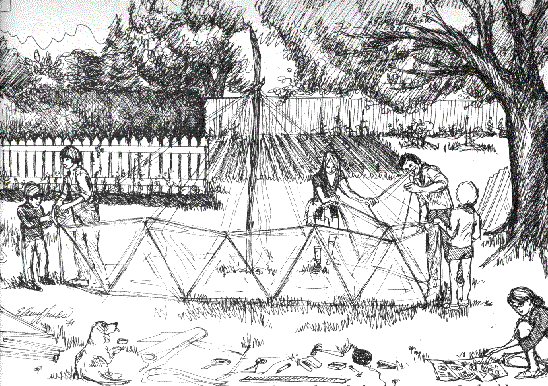
Building the geodexic dome is comparatively simple and inexpensive. It should
take two or three days to complete the job. Costs can run from $50 to about
$200.
5) A description of the food used (worms, insect larvae, etc.) must be given
with the amount listed in pounds.
6) A description of the amount of fertilizer and the source must be given,
including the length of time between changes.
Hopefully we will be able to design a simple colorimetric test for you to
estimate algae production on a weekly basis.
We do not know how successful the Back Yard Fish Farm idea will be. We have
indications from the prototype that it will work. In fact, some of you may
produce edible organic fish at less than 20 cents per pound (exclusive of
your labor), some may even set still-water fish culture records for this
country. All of you will have fun and learn a lot.
The experiment is risky . . . you could also end up with fish only large
enough to feed to the chickens.
This may not make you happy, but your scientific data will tell us what went
wrong. Your Tilapia-Dome can be used as a greenhouse the following winter,
or if you aie excited by aquaculture, you may decide to trap native fishes
and fatten them in the dome in the winter. Thus, the experiment cannot really
fail.
Bill McLarney wants to start a research project to find out if the dome can
be used for two fish crops a year. During the winter he would like to try
fattening bluegills, perch, crayfish and clams to be harvested before the
tilapia experiments begin again in the spring. The majority of us here want
to use the prototype dome for growing kale, spinach, Chinese cabbage and
lettuce this winter. I suspect the cooks rather than the fisherman will win
the first round.
I hope many of you will become involved in the OGF Reader's Research Program.
It could become a potent force for a saner agriculture in this country.
Organic Gardening and Farming - January, 1972 - Page 109
For you trivia fiends out there who feel the need to know about such things,
each OGF page number in this article represents the block of text just above
it. In this eleven page OGF article there were two two page advertising spreads
which will explain the two rifts in the page numbers.
WEBMASTERS:
Click here to generate maximum cash for your web site!



